Influence of High-Frequency Ultrasonic Vibration Load on Pore-Fracture Structure in Hard Rock: A Study Based on 3D Reconstruction Technology
Abstract
:1. Introduction
2. Materials and Methods
2.1. Experimental Equipment
2.1.1. Sample Preparation
2.1.2. Ultrasonic High-Frequency Vibration Test System
2.1.3. Nuclear Magnetic Resonance System
2.1.4. Computed Tomography (CT) Scanning System
2.2. Experimental Procedures
2.2.1. Nuclear Magnetic Resonance Test
2.2.2. CT Scanning Test
3. Results
3.1. Evolution of NMR T2 Spectra of Rock Samples under Ultrasonic Vibration
3.2. Three-Dimensional Pore Fracture Propagation Characteristics of Rock Based on 3D Reconstruction Technology
4. Discussion and Conclusions
Author Contributions
Funding
Institutional Review Board Statement
Informed Consent Statement
Data Availability Statement
Acknowledgments
Conflicts of Interest
References
- Li, X.; Gong, F.; Tao, M.; Dong, L.; Du, K.; Ma, C.; Zhou, Z.; Yin, T. Failure mechanism and coupled static-dynamic loading theory in deep hard rock mining: A review. J. Rock Mech. Geotech. Eng. 2017, 9, 767–782. [Google Scholar] [CrossRef]
- Li, X.; Cao, W.; Tao, M.; Zhou, Z.; Cheng, Z. Influence of unloading disturbance on adjacent tunnels. Int. J. Rock Mech. Min. Sci. 2016, 84, 10–24. [Google Scholar] [CrossRef]
- Wang, S.; Li, X.; Wang, S. Three-dimensional mineral grade distribution modelling and longwall mining of an underground bauxite seam. Int. J. Rock Mech. Min. Sci. 2018, 103, 123–136. [Google Scholar] [CrossRef]
- Wang, S.; Li, X.; Yao, J.; Gong, F.; Li, X.; Du, K.; Tao, M.; Huang, L.; Du, S. Experimental investigation of rock breakage by a conical pick and its application to non-explosive mechanized mining in deep hard rock. Int. J. Rock Mech. Min. Sci. 2019, 122, 104063. [Google Scholar] [CrossRef]
- Noma, K.; Takeda, Y.; Aoyama, T.; Kakinuma, Y.; Hamada, S. High-precision and high-efficiency micromachining of chemically strengthened glass using ultrasonic vibration. In Proceedings of the 6th CIRP International Conference on High Performance Cutting, Berkeley, CA, USA, 23–25 June 2014; Volume 14, pp. 389–394. [Google Scholar]
- Bar-Cohen, Y.; Bao, X.; Chang, Z.; Sherrit, S. An ultrasonic sampler and sensor platform for in situ astrobiological exploration. In Smart Structures and Materials 2003: Smart Structures and Integrated Systems; SPIE: Bellingham, WA, USA, 2003; Volume 5056, pp. 457–465. [Google Scholar]
- Bagde, M.N.; Petros, V. Fatigue properties of intact sandstone samples subjected to dynamic uniaxial cyclical loading. Int. J. Rock Mech. Min. Sci. 2005, 42, 237–250. [Google Scholar] [CrossRef]
- Badescu, M.; Bao, X.; Bar-Cohen, Y.; Chang, Z.; Sherrit, S. Integrated modeling of the ultrasonic/sonic drill/corer—Procedure and analysis results. In Smart Structures and Materials 2005: Smart Structures and Integrated Systems; SPIE: Bellingham, WA, USA, 2005; Volume 5764, pp. 312–323. [Google Scholar]
- Wiercigroch, M.; Wojewoda, J.; Krivtsov, A.M. Dynamics of ultrasonic percussive drilling of hard rocks. J. Sound Vib. 2005, 280, 739–757. [Google Scholar] [CrossRef]
- Li, S.; Tian, S.; Li, W.; Ling, X.; Kapitaniak, M.; Vaziri, V. Numerical study on the elastic deformation and the stress field of brittle rocks under harmonic dynamic load. Energies 2020, 13, 851. [Google Scholar] [CrossRef]
- Li, S.; Yan, L.; Li, W.; Zhao, H.; Ling, X. Research on Energy Response Characteristics of Rock under Harmonic Vibro-Impacting Drilling. J. Vib. Eng. Technol. 2019, 7, 487–496. [Google Scholar] [CrossRef]
- Zhao, D.; Zhang, S.; Wang, M. Microcrack Growth Properties of Granite under Ultrasonic High-Frequency Excitation. Adv. Civ. Eng. 2019, 2019, 3069029. [Google Scholar] [CrossRef]
- Yin, S.; Zhao, D.; Zhai, G. Investigation into the characteristics of rock damage caused by ultrasonic vibration. Int. J. Rock Mech. Min. Sci. 2016, 84, 159–164. [Google Scholar] [CrossRef]
- Zhou, Y.; Tang, Q.; Zhang, S.; Zhao, D. The Mechanical Properties of Granite under Ultrasonic Vibration. Adv. Civ. Eng. 2019, 2019, 9649165. [Google Scholar] [CrossRef]
- Zhao, D.; Zhang, S.; Zhao, Y.; Wang, M. Experimental study on damage characteristics of granite under ultrasonic vibration load based on infrared thermography. Environ. Earth Sci. 2019, 78, 419. [Google Scholar] [CrossRef]
- Zhang, L.; Wang, X.; Wang, J.; Yang, Z.; Ma, T. Research on Fracture Characteristics and Energy Dissipation of Hard Rock under the Excitation of Ultrasonic Vibration. Geofluids 2022, 2022, 8351316. [Google Scholar] [CrossRef]
- Yang, Z.; Wang, X.; Zhang, L.; Wang, J. Research on influencing factors of rock breaking efficiency under ultrasonic vibration excitation. AIP Adv. 2023, 13, 025160. [Google Scholar] [CrossRef]
- Zhou, Y.; Zhao, D.; Tan, Q.; Wang, M. Experimental and numerical investigation of the fatigue behaviour and crack evolution mechanism of granite under ultra-high-frequency loading. R. Soc. Open Sci. 2020, 7, 200091. [Google Scholar] [CrossRef] [PubMed]
- Bieniawski, Z.T.; Bernede, M.J. Suggested methods for determining the uniaxial compressive strength and deformability of rock materials. Int. J. Rock Mech. Min. Sci. Geomech. Abstr. 1979, 16, 138–140. [Google Scholar] [CrossRef]
- Yan, L.; Liu, L.; Zhang, S.; Lan, D.; Liu, J. Testing of Weakly Weathered Granites of Different Porosities Using a Split Hopkinson Pressure Bar Technique. Adv. Civ. Eng. 2018, 2018, 5267610. [Google Scholar] [CrossRef]
- Wang, Y.; Hou, Z.Q.; Hu, Y.Z. In Situ X-ray Computed Tomography Experiment on Mesodamage Evolution of Subgrade Bimsoil during Cycle Loading. J. Mater. Civ. Eng. 2019, 31, 04019198. [Google Scholar] [CrossRef]



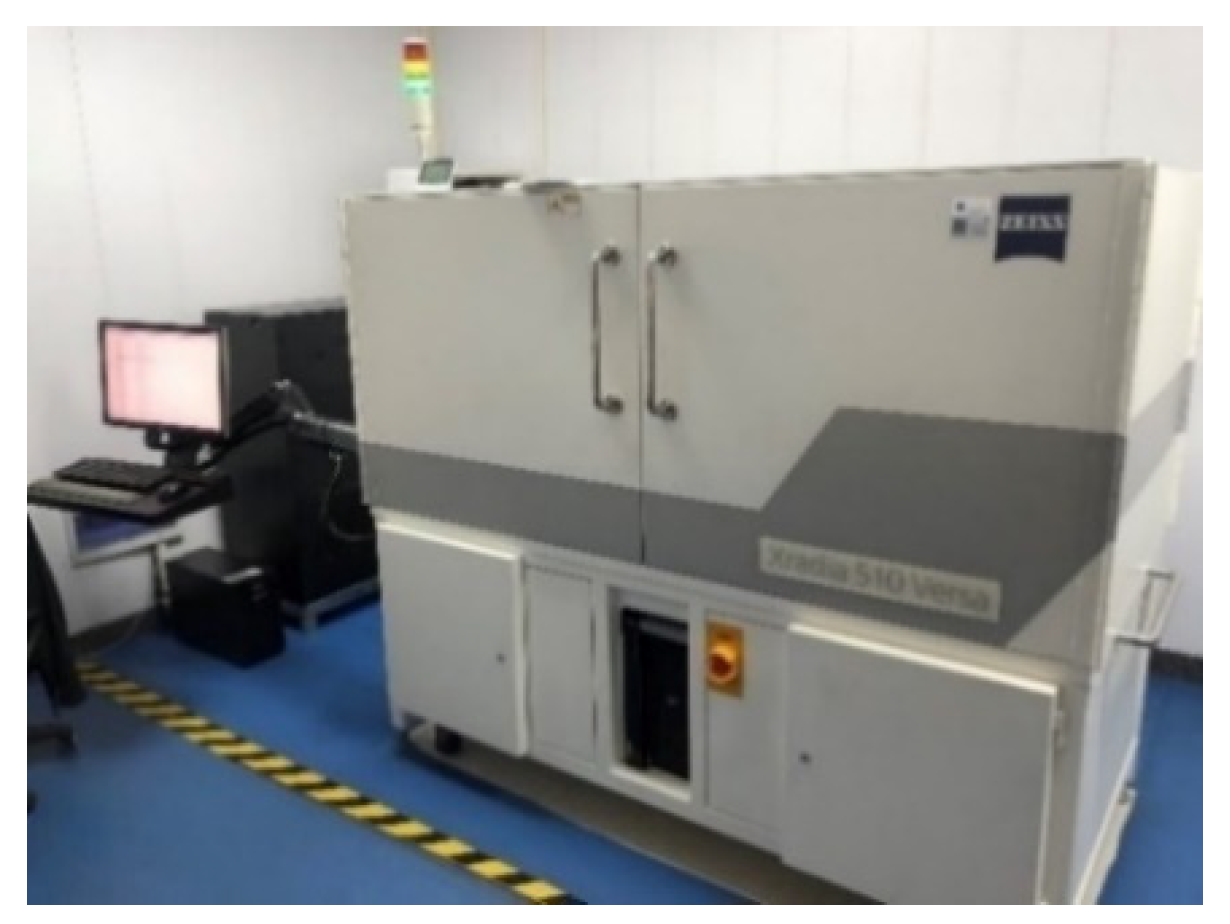
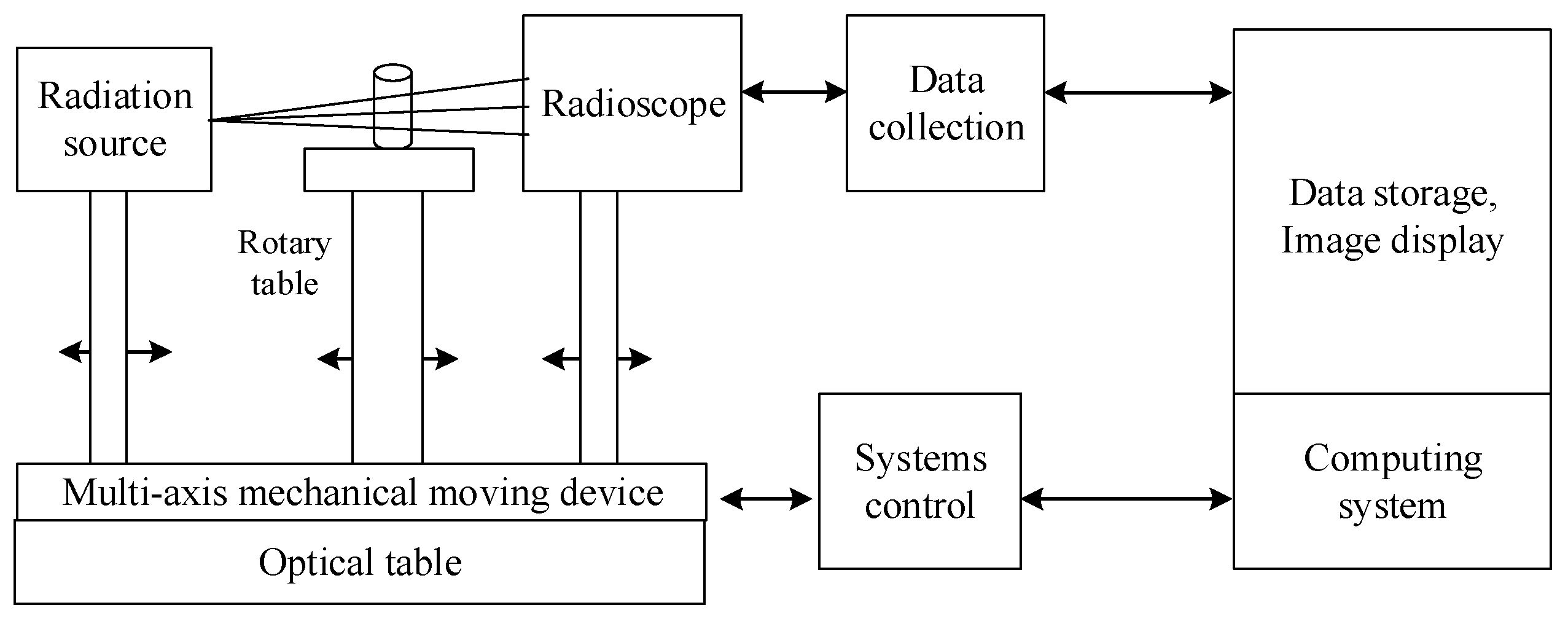
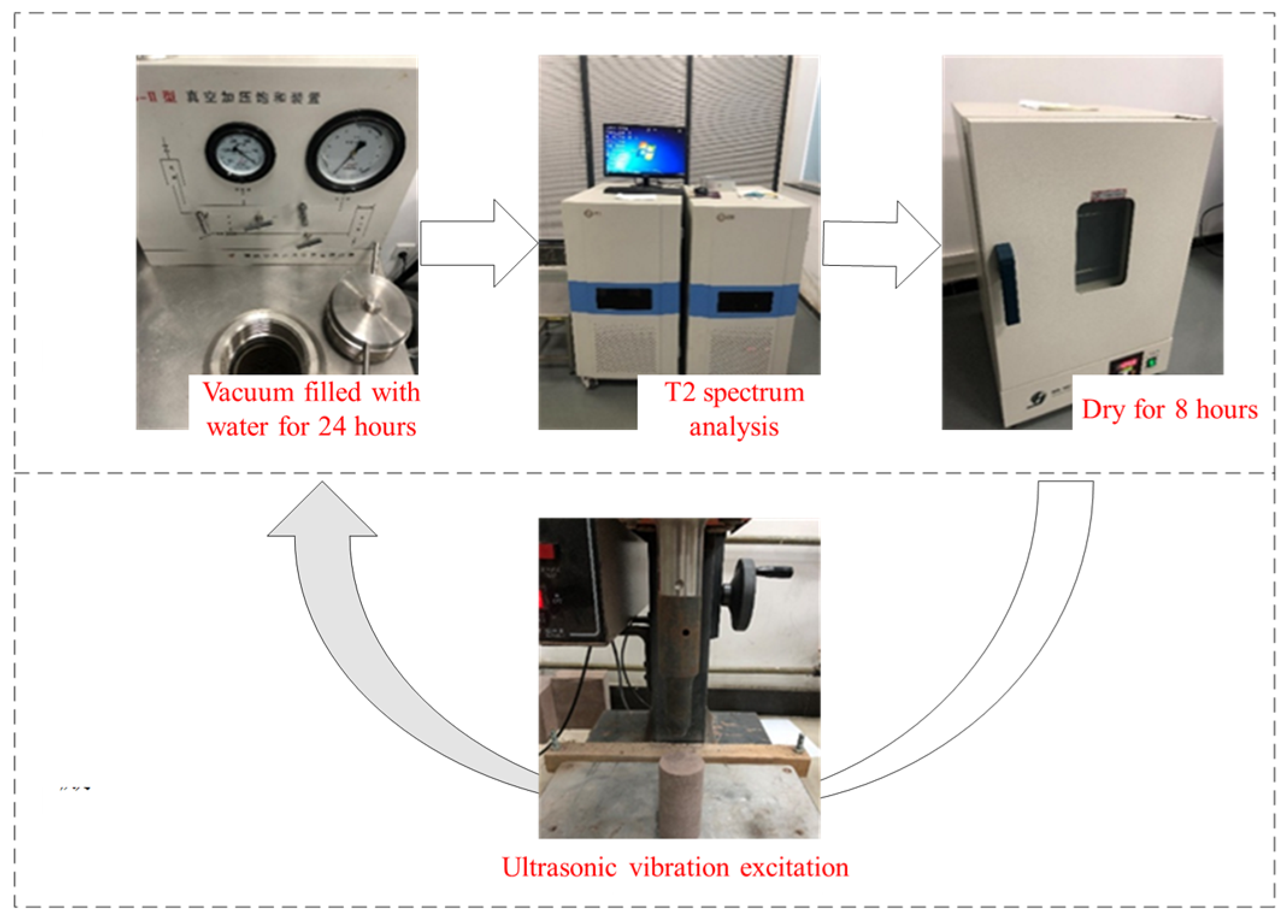
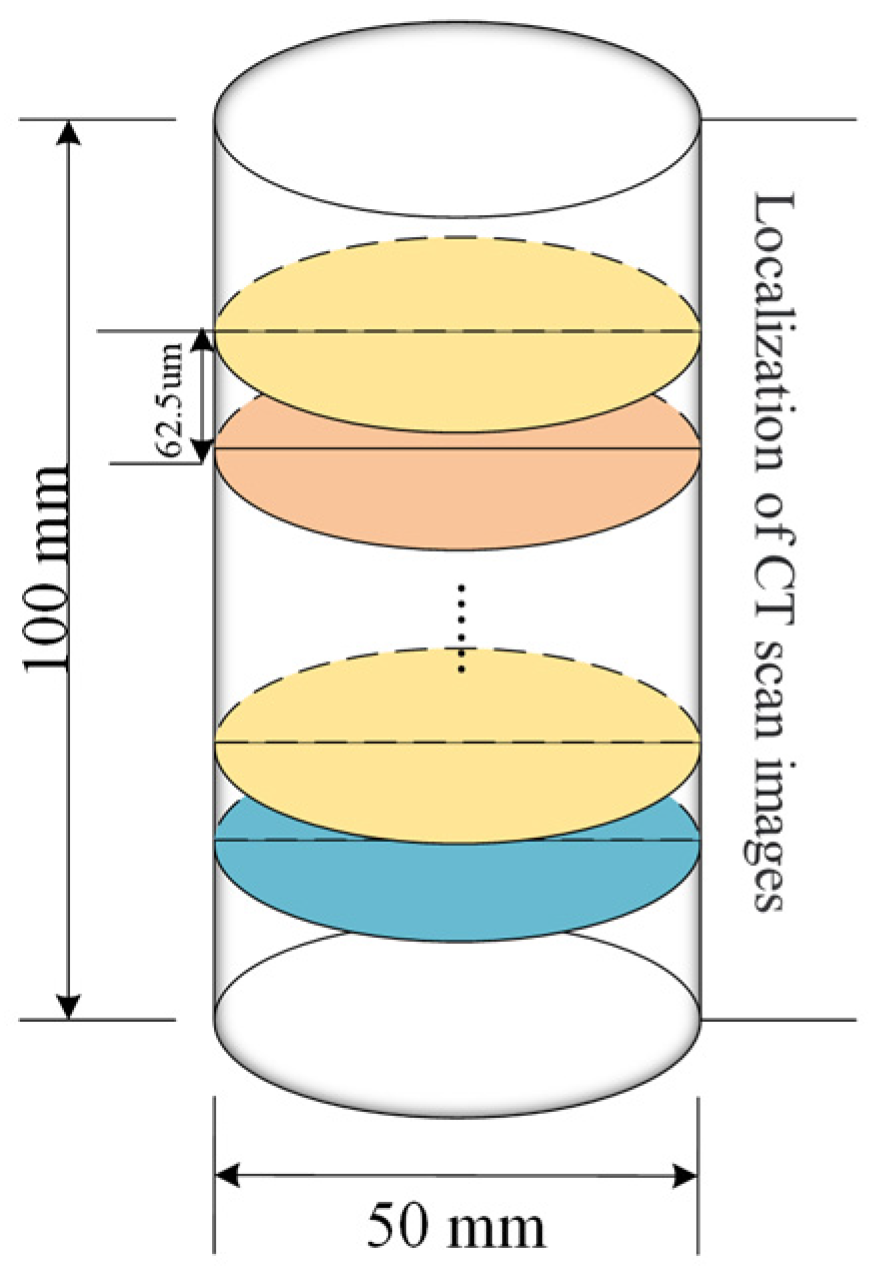


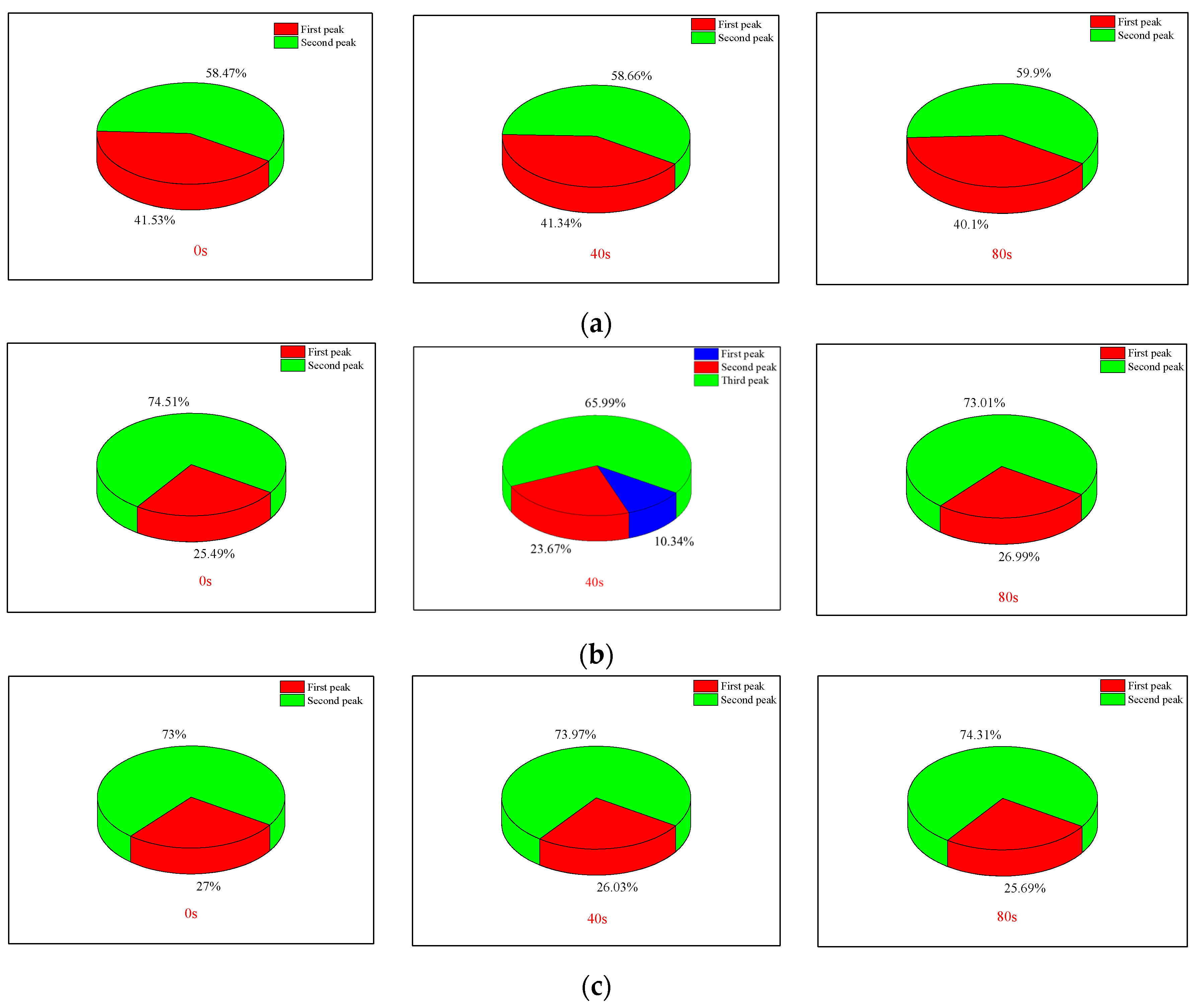
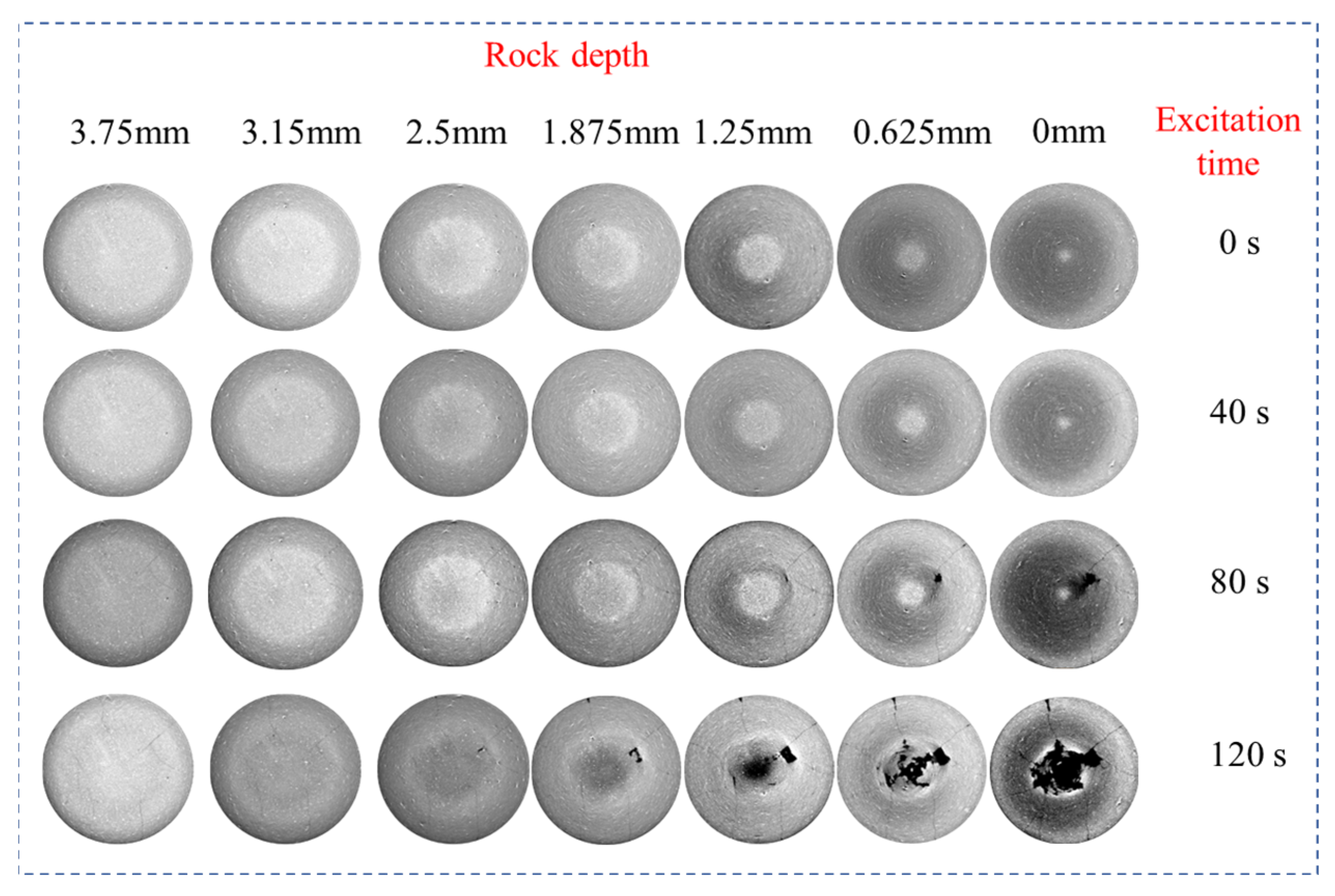
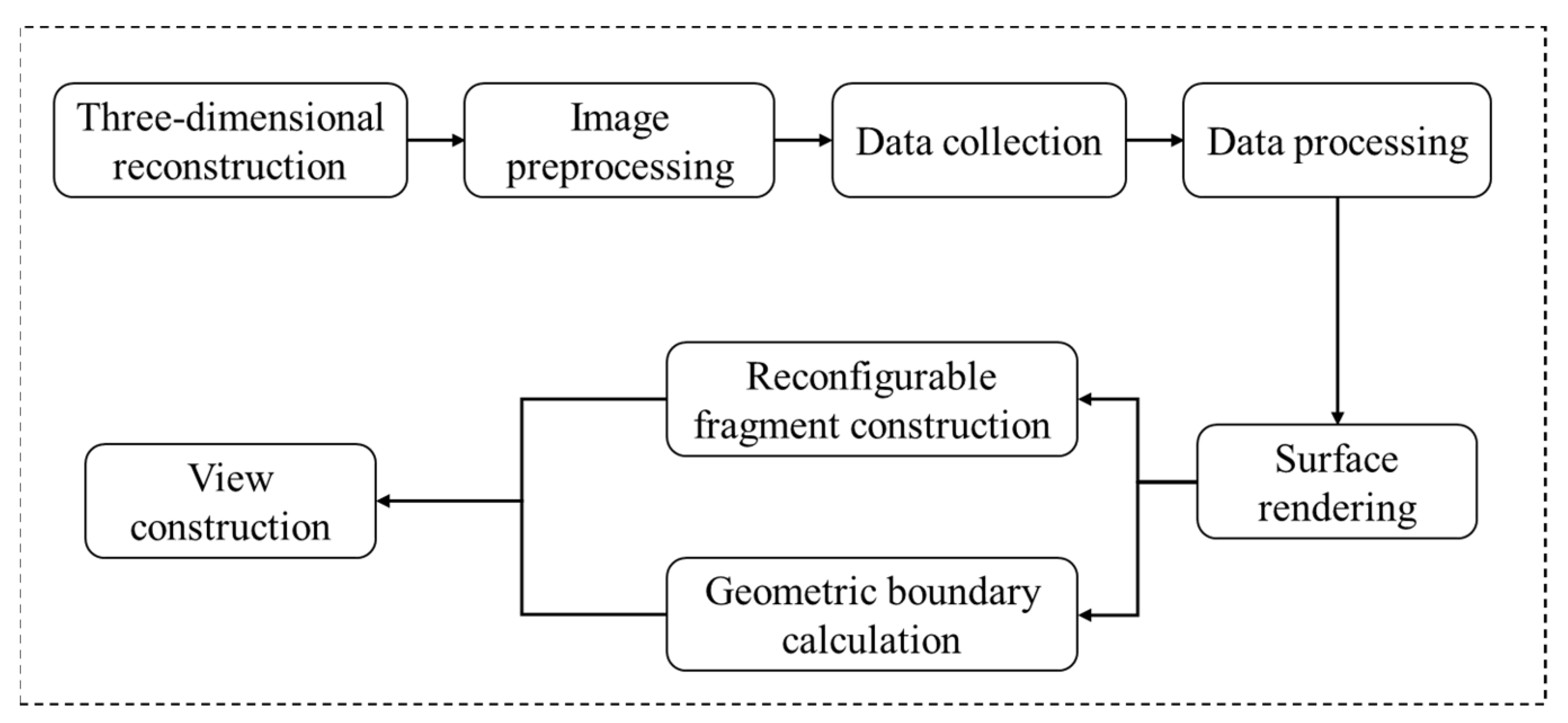

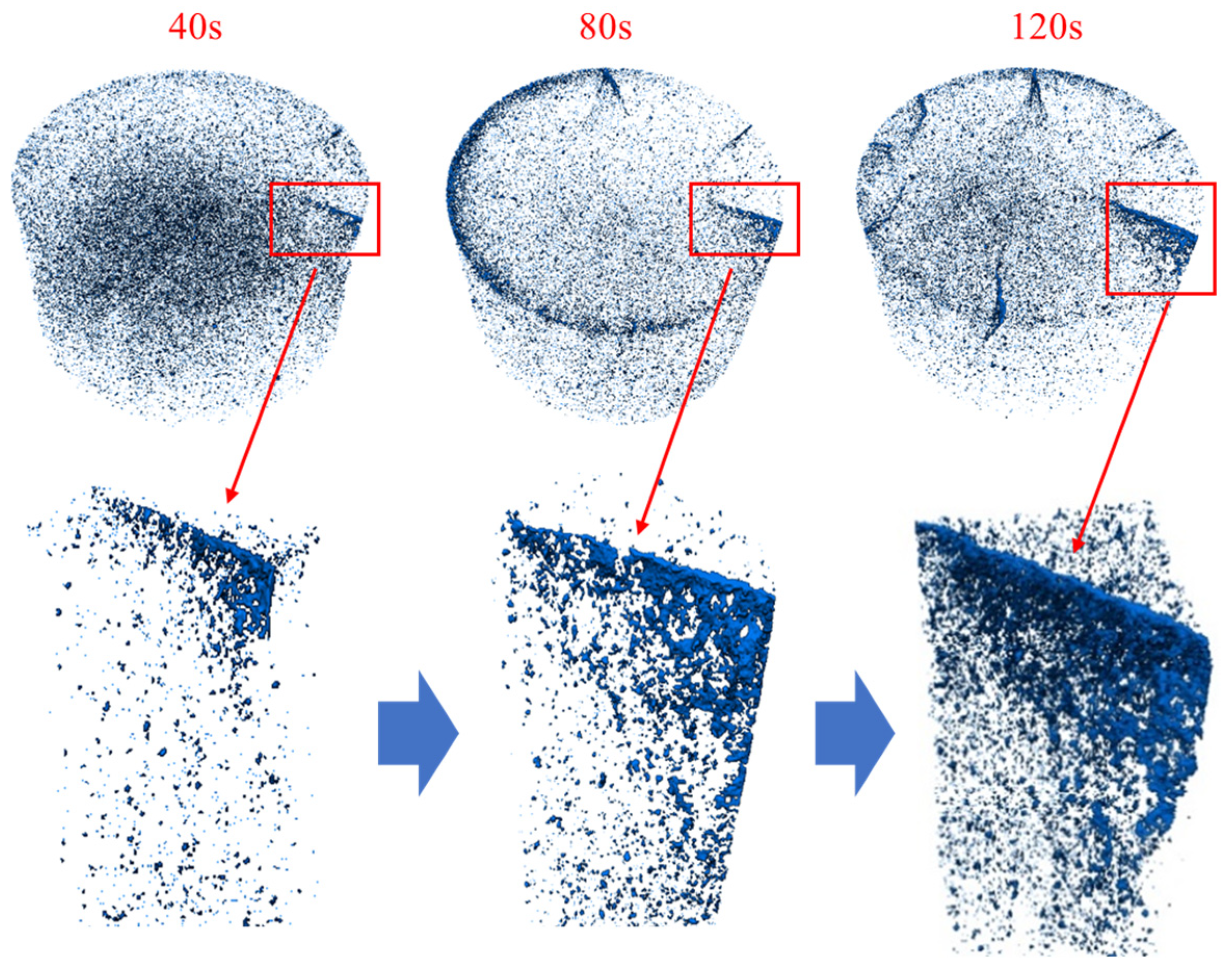
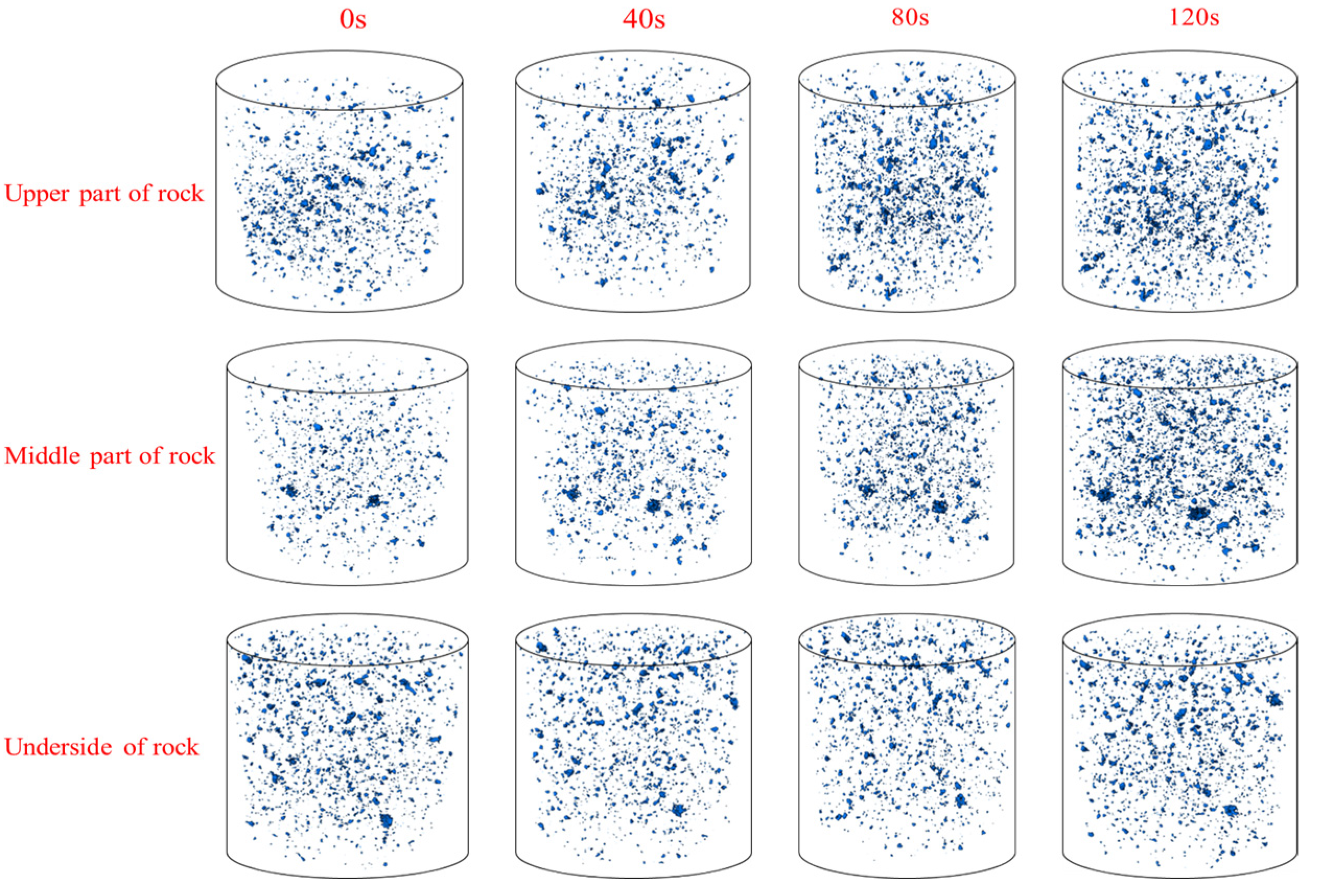

| Time/s | Pore Size Distribution (Number of Pixels) | ||||||
|---|---|---|---|---|---|---|---|
| 1–10 | 11–20 | 21–30 | 31–40 | 41–50 | >50 | Total Quantity | |
| 0 s | 10,950 | 185 | 60 | 9 | 13 | 24 | 11,241 |
| 40 s | 15,920 | 358 | 80 | 30 | 24 | 40 | 16,452 |
| 80 s | 21,337 | 728 | 168 | 87 | 37 | 80 | 22,437 |
| 120 s | 25,545 | 1211 | 361 | 174 | 107 | 205 | 27,603 |
| Time/s | Pore Size Distribution (Number of Pixels) | ||||||
|---|---|---|---|---|---|---|---|
| 1–10 | 11–20 | 21–30 | 31–40 | 41–50 | >50 | Total Quantity | |
| 0 s | 10,690 | 142 | 50 | 15 | 9 | 15 | 10,921 |
| 40 s | 11,778 | 162 | 55 | 21 | 9 | 16 | 12,041 |
| 80 s | 14,621 | 299 | 74 | 38 | 18 | 37 | 15,087 |
| 120 s | 18,262 | 680 | 189 | 81 | 43 | 63 | 19,318 |
| Time/s | Pore Size Distribution (Number of Pixels) | ||||||
|---|---|---|---|---|---|---|---|
| 1–10 | 11–20 | 21–30 | 31–40 | 41–50 | >50 | Total Quantity | |
| 0 s | 10,030 | 121 | 40 | 20 | 4 | 13 | 10,228 |
| 40 s | 10,091 | 124 | 41 | 20 | 8 | 13 | 10,297 |
| 80 s | 10,112 | 227 | 43 | 22 | 9 | 14 | 10,427 |
| 120 s | 10,131 | 231 | 43 | 26 | 11 | 14 | 10,456 |
Disclaimer/Publisher’s Note: The statements, opinions and data contained in all publications are solely those of the individual author(s) and contributor(s) and not of MDPI and/or the editor(s). MDPI and/or the editor(s) disclaim responsibility for any injury to people or property resulting from any ideas, methods, instructions or products referred to in the content. |
© 2024 by the authors. Licensee MDPI, Basel, Switzerland. This article is an open access article distributed under the terms and conditions of the Creative Commons Attribution (CC BY) license (https://creativecommons.org/licenses/by/4.0/).
Share and Cite
Zhang, J.; Zhang, L.; Wang, X.; Niu, Z.; Yang, Z. Influence of High-Frequency Ultrasonic Vibration Load on Pore-Fracture Structure in Hard Rock: A Study Based on 3D Reconstruction Technology. Materials 2024, 17, 1127. https://doi.org/10.3390/ma17051127
Zhang J, Zhang L, Wang X, Niu Z, Yang Z. Influence of High-Frequency Ultrasonic Vibration Load on Pore-Fracture Structure in Hard Rock: A Study Based on 3D Reconstruction Technology. Materials. 2024; 17(5):1127. https://doi.org/10.3390/ma17051127
Chicago/Turabian StyleZhang, Jianguo, Lei Zhang, Xufeng Wang, Zhijun Niu, and Zhanbiao Yang. 2024. "Influence of High-Frequency Ultrasonic Vibration Load on Pore-Fracture Structure in Hard Rock: A Study Based on 3D Reconstruction Technology" Materials 17, no. 5: 1127. https://doi.org/10.3390/ma17051127







